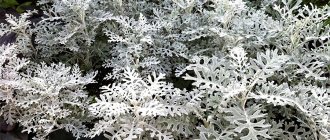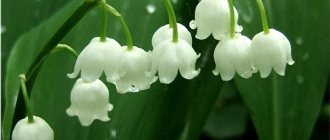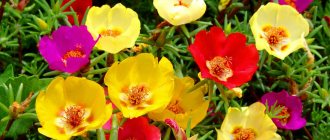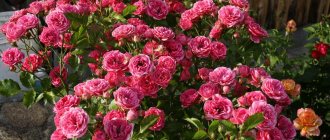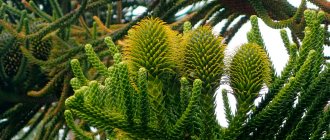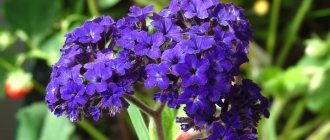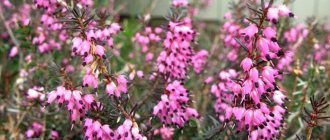Description
As shown in the photo of the shoot, its shoots can be erect and ascending, pubescent and bare. The height of this flower does not exceed 0.3 m. The roots are powerful, located close to the soil surface.
The process of rooting creeping stems is quick and easy. The leaves are small, entire, pubescent, placed oppositely.

The photo of the flowers of the jasper shows that their diameter does not exceed 2 cm. The color of the petals is white, there is a double cut. The fruits are presented in capsules with dark seeds inside.
Seedling method
This is the most preferred way to obtain a new plant. In this case, it is recommended to plant seeds in February-March. The first shoots may appear within 7 days.
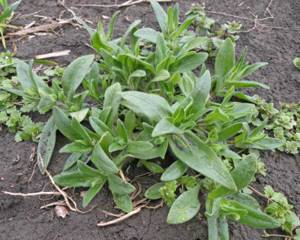
Planting seedlings with seedlings is not difficult. It is only important to moisten and loosen the soil in a timely manner. After the first true leaves appear, you should pick, planting the plants in separate cups. The recommended time for planting seedlings in open soil is July.
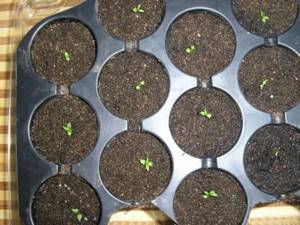
Reproduction
The plant is so easily propagated by division and cuttings that the seed method should be used only in the absence of vegetative planting material.
Dividing the bush
The procedure is carried out in early spring after the snow has melted and the soil has sufficiently warmed up. It should be remembered that flowers belong to early crops, so you should not delay replanting. Bushes intended for transplantation are cut low, almost to the root, and left for several days so that they begin to grow. After this, the bush is dug up and carefully divided into parts, each of which is replanted like an adult plant. During the first week, it is advisable to provide shade and good watering.
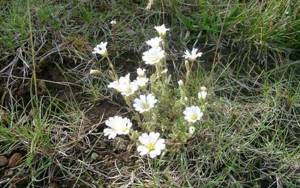
Autumn division of cherry bushes is permissible only in the southern regions.
By cuttings
Summer flowering cuttings can be used for planting. The best survival rate is shown by June cuttings. The cut stems are rooted in the training bed by sticking them into the ground and compacting it lightly. To speed up the process, the divisions can be covered with a bag or glass jar on top. As soon as young shoots appear, the cover must be removed. It will be possible to transplant to a permanent place in August or early autumn, without delaying until the cold weather.
Seeds
The seed material has good germination, and is quite resistant to low temperatures, so planting can be done in open ground in mid-April. If desired, you can also use the seedling method; in this case, you need to sow the seeds in March. Sowing is done in a standard manner, the planting depth is maintained in accordance with the size of the seeds. Watering both before emergence (about 2 weeks) and after should be done very sparingly to avoid rotting of seeds and seedlings. The seedlings are transferred to a permanent location in July. The seed-grown plant blooms in the second year.
Rules for planting a tree on the site
This ground cover prefers sunny places with good wind protection. To prevent the tree from spreading too quickly, you need to determine the perimeter after planting and make a limitation around it.

The plant is unpretentious to soil. Even rocky soil is suitable. But it is still better that the soil is loose and light, has a neutral pH and good breathability.

21 days before planting, experts advise carefully digging up the area and adding humus (6 kg per 1 sq. m). The recommended digging depth is 0.5 m. Loams and clay require the addition of sand.
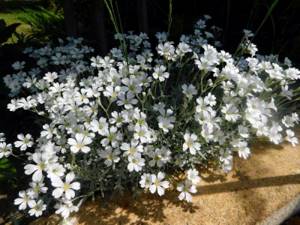
Before planting seedlings, the soil should be loosened and the planting material should be hardened. The optimal distance between the holes is considered to be 30 cm. After planting, the flowers need to be watered abundantly. Flowering can be observed after a year.
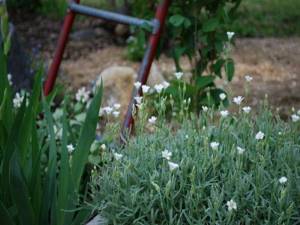
Popular types and varieties
The genus of moth is very numerous; up to 200 species are found in nature. The following are popular in culture:
- Jaskolka Bieberstein . The most popular type among flower growers and landscape designers. The leaf blades are pubescent, gray-green, the shoots are creeping. Peduncles rise high. The flowers are bright white, small, no more than 1.5 cm. The most famous varieties are “Silver Carpet,” which is valued for its beautiful, rich silver foliage, and “Snow Carpet,” which is especially decorative during flowering.
- Alpine parsley . Among the cultivated species, it is the most unpretentious, feels good in dry conditions and does not tolerate wetlands at all. The perennial compact bush is not as lush as other varieties; it does not rise in height by more than 15 cm. The silvery leaves have a rounded shape. The inflorescences are also quite rare, but they look charming both on a personal plot and collected cut into small bouquets. This species is less inclined than others to seize territory.
- Felt cleaver. A fast-growing, quite aggressive variety that can quickly take over free territories and even displace some of its neighbors. Looks especially good on slopes, natural and artificial terraces. In 3-4 years, one bush can grow into a “cushion” up to 1.5 m in diameter. The leaves are heavily pubescent and rounded. It blooms with milky-white “stars” a little earlier than other varieties; in warm spring it can produce buds as early as April. The most decorative variety of this series is “Crystal Falls”.
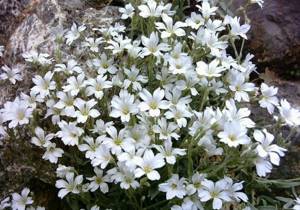
Bieberstein
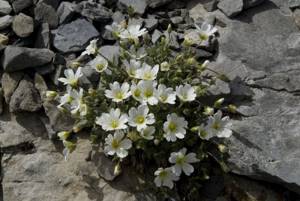
Alpine
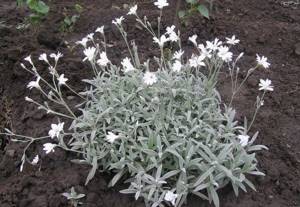
Felt
Top dressing
To fertilize or not to fertilize the sapling? There is no exact answer to this question. According to some experts, the plant does not need feeding.

Others believe that fertilization is necessary. If you adhere to the latter statement, it is recommended to alternate between liquid manure and minerals.
Jaskolka in landscape design
The plant does not require annual replanting, so it often becomes an indispensable part of the landscape. They can be used to decorate borders and the base of alpine hills. The plant is planted in the middle of the flowerbed, and the outskirts are framed with plants of other colors. You can plant calendula and red tulips around. Rock gardens, terraces, and garden paths are decorated with a jar. Some varieties with silver leaves fit effectively into a rocky landscape and cover bare, gray places on the site.
In the flowerbed, the flowerbeds are in harmony with:
- daffodils;
- daisies;
- bells;
- sedums.

Yascolka is an elegant plant that gives the site a rich, blooming appearance. Caring for it is absolutely not burdensome; even those who do not have sufficient experience in floriculture can grow the crop. Thanks to its long flowering and neat appearance, the plant is becoming a favorite of many gardeners.
After watching the following video, you can learn more useful information about growing Yaskolka in open ground:
Jaskolka in autumn
In one and the same place, a sprout can grow for many years. However, at a certain point the flower will become so large that it will need to be replanted.
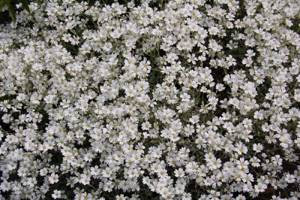
In such a situation, it is appropriate to propagate the plant by dividing it into parts. But before that it needs to be trimmed heavily. The recommended frequency of replanting is 5 years.
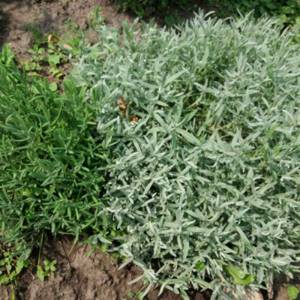
Watering
The culture is quite drought-resistant, but you should remember about the superficial location of the root system. In dry summers, the plant needs to be watered regularly, avoiding stagnation of water. In spring and with the onset of autumn, watering is practically not required, provided there is regular rainfall.
Yaskolka can be grown in one place, without replanting, for several years. But, if such a need arises, she will easily endure a housewarming party, including dividing the bush. Moreover, it serves to rejuvenate her and improve her appearance.

Wintering
If the winters in your region are mild enough, then you may not cover the flowers. However, if there is a risk of frost, then it is better to take care.

The optimal materials are spunbond and lutrasil. It is not advisable to use spruce branches and fallen leaves.
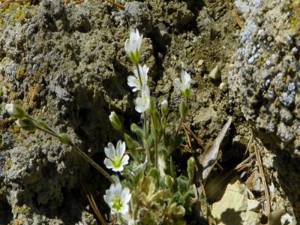
Types of parsley
Today, two hundred species of jasmine flower are known. Below are those that are most popular among gardeners.
Jaskolka Bieberstein
Homeland - Crimea. Characteristics:
- petiolate or linear leaves;
- flowering stems 0.2 m long;
- flowers are collected in umbrella inflorescences.
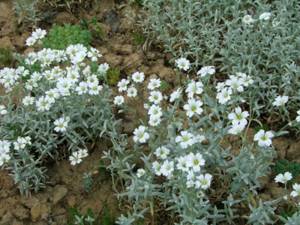
A seed plant is an excellent solution for decorating a garden. Its advantages include low maintenance and variety of types. The main thing in growing this plant is to choose the right place.
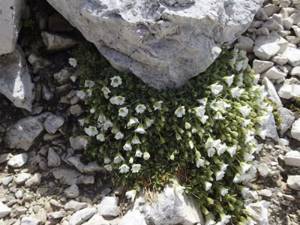
Required care
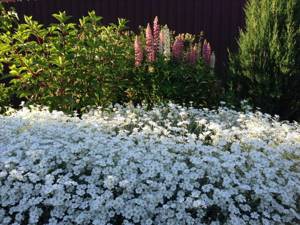
Planting and caring for the Bieberstein cherry, as well as other species, is very simple, so even beginners in the field of floriculture can do it. The main thing in care is watering, which will need to be done once every 7 days. Sometimes you will need to loosen the soil. If the flower grows excessively, you can remove unnecessary stems. Many varieties are characterized by frost resistance. For the rest, additional shelter will need to be created to help them survive the colder times. To do this, the plants are covered with peat or spruce branches; the stems must be trimmed to 1 cm in advance.
According to many gardeners, the plant does not particularly need any feeding, but some believe that fertilizers are still needed so that the flower grows faster and blooms more luxuriantly. It is necessary to fertilize after the plant is planted and also when it begins to bloom.
Reproduction methods
The jasper is not a whimsical plant; propagating it is also not difficult. To carry out the process, you can use methods suitable for propagating all perennials:
- Cuttings. It is better to do the procedure in the spring, when flower stalks have not yet formed. You can begin propagation in the fall, when the plant has completely faded. Cut the shoots and root them in the garden. Make shelter in the form of caps.
- Dividing the bush. When early spring arrives, the bushes begin to slowly grow. At this time, the plants are dug up and divided into a couple of parts, after which they are planted separately from one another.
If you plan to propagate the seedling by cuttings, then, according to gardeners, it is better to do this in June than in the fall, since this turns out to be more effective.
Replanting the plant should be done no more than once every 5 years. It is important to choose a place where the sun's rays will penetrate unhindered; a little shade is acceptable.
Presence of diseases and pests
The moth is simple in everything, even diseases and pests practically do not affect it. Only sometimes can a plant suffer from a fungal infection, but this happens if the bush is not taken care of at all or is over-moistened.
It is important to periodically trim wilted stems. Thanks to this, the plant will look more compact and well-groomed. Also, such a procedure can increase the plant’s immunity and resistance to diseases.


